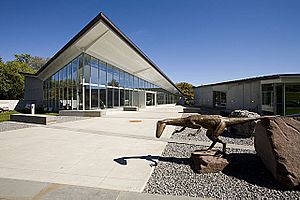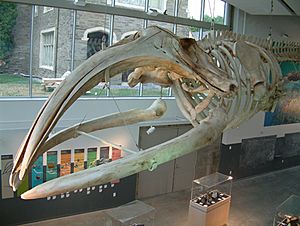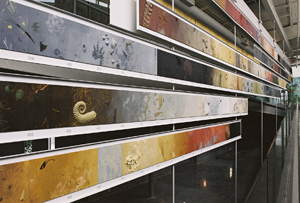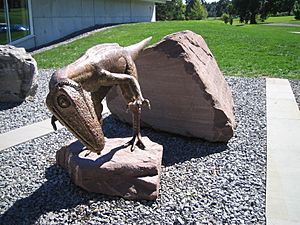Museum of the Earth facts for kids
 |
|
 |
|
| Lua error in Module:Location_map at line 420: attempt to index field 'wikibase' (a nil value). | |
| Established | 2003 |
|---|---|
| Location | 1259 Trumansburg Road, Ithaca, New York |
| Visitors | 30,000 |
| Architect | Weiss/Manfredi |
| Ithaca Discovery Trail | |
|
|
The Museum of the Earth is a cool natural history museum located in Ithaca, New York. It opened in 2003 and is part of the Paleontological Research Institution (PRI). PRI is an organization that studies the history of Earth and its life. Both the museum and PRI work closely with Cornell University. The Museum of the Earth has awesome exhibits about Earth science and art that shows how Earth and life have changed together over time.
Contents
History of the Museum
In 1994, the leaders of PRI decided to plan a museum. They received $2 million from the state to start designing the Museum of the Earth in 1999. Building the museum began in 2001 and finished in 2003. It cost over $11 million to build. The museum officially opened its doors to the public on September 29, 2003.
The museum building is about 18,000 square feet. It was designed by a New York architecture company called Weiss/Manfredi. The building looks like a gorge, which is a deep valley with steep sides. It has two main parts separated by an open area in the middle. This design won awards in 2004. In early 2025, the museum faced a challenge when it was reported that it might have to close due to a lack of funding.
Awesome Exhibits
The museum has several amazing permanent exhibits. These include the North Atlantic Right Whale #2030, Rock of Ages, Sands of Time, and A Journey Through Time.
North Atlantic Right Whale #2030
North Atlantic Right Whale #2030 was a whale that sadly died in May 1999. She got badly tangled in fishing gear. Rescuers tried to help her, but she swam away and later died from her injuries.
The museum's director, Warren D. Allmon, wanted to get the whale's skeleton. On October 21, 1999, he learned that the 44-foot-long whale had been found dead. PRI was told they could have the skeleton if they helped clean the huge 30-ton whale. Three days later, the bones arrived at PRI. They were buried in horse manure for several months to clean them completely. After cleaning, the skeleton was put together on a steel frame. The museum building was designed so the whale could be brought inside easily. In November 2002, a crane lifted the skeleton into the building.
By 2004, a permanent exhibit about the whale was set up. It includes parts of the whale's baleen (filter-feeding plates) and a short film. The film shows the sad attempts to rescue the whale from the fishing gear.
Rock of Ages Sands of Time Mural
Rock of Ages, Sands of Time is a huge series of 544 paintings by artist Barbara Page. Each painting is 11x11 inches and represents 1 million years of Earth's history. Together, they show the last 544 million years, from the Cambrian Explosion to today. Each painting shows life-size images of fossils from that time period. These images are based on real fossils from PRI's collections. The entire mural is about 500 feet long. It is displayed along a ramp that leads visitors to the lower exhibits.
A Journey Through Time Exhibit
A Journey Through Time takes visitors on a trip through four billion years of history. It starts from the Big Bang and goes all the way to today. It also looks at how humans affect the Earth's future. This exhibit teaches about geologic processes (how Earth changes), evolution, and biodiversity (the variety of life). It shows many different fossils from PRI's collections. One highlight is the largest complete fossil eurypterid (an ancient sea scorpion) ever found!
This exhibit has three main parts:
- The Devonian period in Central New York.
- The Triassic and Jurassic periods in Connecticut, Newark, and the Hudson Valley.
- The Quaternary glaciation (Ice Age).
Some cool things to see in this exhibit are the Hyde Park Mastodon, the Discovery Labs, coral reef aquariums, a glacier exhibit, and short films narrated by geologist Frank H.T. Rhodes. You can also see Steggy the Stegosaurus and Amelia the Quetzalcoatlus. There's even a garden that looks like the northeastern United States during the Ice Age, with tundra plants and huge glacial erratic boulders.
The Hyde Park Mastodon
The Hyde Park mastodon was found in 1999. A family in Hyde Park, New York was digging a pond in their backyard when they saw some unusual "logs." These turned out to be the bones of an American mastodon (Mammut americanum). In June 2000, PRI staff and volunteers started digging up the site. They found over 95% of the mastodon's bones, including both tusks, the skull, and major leg bones. This makes the Hyde Park mastodon one of the most complete skeletons ever found! It was likely an older male that weighed between 10,000 and 15,000 pounds.
After the dig, the bones were sent to the University of Michigan to be studied and cast. Then, they went to Alberta, Canada to build a frame for the skeleton. In September 2003, the Hyde Park mastodon was put on display at the Museum of the Earth.
Discovery Labs
The Museum of the Earth's Discovery Labs offer fun, hands-on learning.
- The Prep Lab lets you watch scientists prepare fossils for research and display.
- In the Fossil Lab, you can search for and identify fossils in local shale rock.
- The Dino Zone is a dinosaur-themed play and learning area for younger kids.
Coral Reef Aquariums
The coral reef exhibit is in the Ice Age section of A Journey Through Time. It features reefs from the Indo-Pacific and Caribbean regions. Both aquariums are designed to be accurate and teach about protecting our environment.
Glacier Exhibit
The glacier exhibit was built to celebrate the museum's 10th anniversary. Visitors can learn about glaciers and how they shaped the Finger Lakes region. You can even walk through an interactive ice cave!
Steggy the Stegosaurus
Steggy the Stegosaurus is a special gift to the Museum of the Earth from the National Museum of Natural History in Washington, DC.. This life-size model was made from papier-mâché in 1904 for an exhibition. It was displayed at the Smithsonian Institution for over 100 years! In 2015, Steggy was fixed up and moved to the Museum of the Earth. You can find Steggy next to the Dino Zone in the museum's Jurassic area.
Amelia the Quetzalcoatlus
In 2016, Amelia the Quetzalcoatlus also came to the Museum of the Earth from the National Museum of Natural History, joining Steggy. This model of a pterosaur (a flying reptile) was named after Amelia Earhart. Her name was chosen after a contest during the model's installation. Amelia is also in the Jurassic area of A Journey Through Time with Steggy.
Educational Programs
The Museum of the Earth wants everyone to enjoy learning, from kids to adults, and from scientists to people who are just curious. Because it works with Cornell University, the museum also provides helpful materials for teachers.
Cecil A. Physis, the Museum Mascot
Cecil A. Physis is the Museum of the Earth's official mascot. Cecil is a Coelophysis, a type of dinosaur. You can see a life-size bronze statue of Cecil near the museum's entrance. It was made by a Brazilian sculptor. Dinosaur fossils are very rare in Central New York. The only known ones are small footprints thought to be from Coelophysis. That's why this species is called “New York’s only known dinosaur.” A running Coelophysis is even on the logos of PRI and the Museum of the Earth. The museum also has three Coelophysis footprints preserved in rock slabs.
Ithaca Discovery Trail
The Museum of the Earth is part of Ithaca's Discovery Trail. This trail connects the museum with seven other educational places in the area. These include the Cayuga Nature Center, the Cornell Lab of Ornithology, the Cornell Botanic Gardens, the History Center, the Johnson Museum of Art, the Sciencenter, and the Tompkins County Public Library. The Discovery Trail started in 1999.






